Rajgir
Rajgir (historically known as Girivraj) is an ancient city and a notified area in Nalanda district in the Indian state of Bihar. The city of Rajgir (ancient Rājagṛha; Pali: Rājagaha) was the first capital of the kingdom of Magadha, a state that would eventually evolve into the Mauryan Empire.[4] The city finds mention in India's greatest literary epic, the Mahabharata, through its king Jarasandha. Its date of origin is unknown, although ceramics dating to about 1000 BC have been found in the city. The famous 2,500-year old Cyclopean Wall (Cyclopean masonry) is located in the city. This area is also notable in Jainism and Buddhism.[5] It was the birthplace of the 20th Jain Tirthankar Munisuvrata, and is closely associated with the arihant Mahavira and Gautama Buddha.[6] Both Lord Mahavira and Lord Buddha taught their beliefs in Rajgir during the 6th and 5th century BC.[7] The ancient Nalanda university was located in the vicinity of Rajgir, and the contemporary Nalanda University named after it was founded in 2010 at Rajgir.[8] It was also through Rajgir that the Mauryan Emperor Ashoka travelled to Bodh Gaya around 250 BC, when placing the diamond throne (Vajrasana) at the great temple where Lord Buddha attained enlightenment.
Rajgir Rajgriha | |
|---|---|
Historical city | |
Clockwise from top : Vishwa Shanti Stupa, Vulture's Peak, View of Rajgir Hills, Son Bhandar Caves, Ancient Cyclopean Walls. | |
| Nickname(s): Court of Magadha Empire, The Abode of the King[1] | |
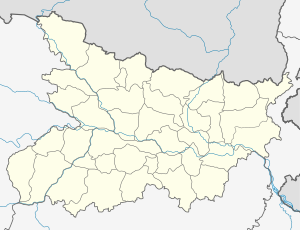 Rajgir Bihar  Rajgir Rajgir (India) | |
| Coordinates: 25.03°N 85.42°E | |
| Country | |
| State | Bihar |
| Region | Magadha |
| Division | Patna |
| District | Nalanda |
| Ward | 19 wards |
| founded | ≈2000 BCE |
| Founded by | Samrat Brihadratha |
| Area (2015) [A 1] | |
| • City | 61.6 km2 (23.8 sq mi) |
| • Regional planning | 517 km2 (200 sq mi) |
| Elevation | 73 m (240 ft) |
| Population (2011)[3] | |
| • Total | 41,587 |
| Time zone | UTC+5:30 (IST) |
| PIN | 803116 |
| Telephone code | +91-6112 |
| Vehicle registration | BR-21 |
| Sex ratio | 1000/889 ♂/♀ |
| Literacy | 51.88% |
| Lok Sabha constituency | Nalanda |
| Vidhan Sabha constituency | Rajgir (SC) (173) |
| Website | nalanda |
| Pilgrimage to |
| Buddha's Holy Sites |
|---|
 |
| The Four Main Sites |
| Four Additional Sites |
| Other Sites |
|
| Later Sites |
|
History
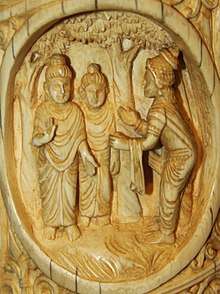
Rajgir is also famous for its association with Haryanka dynasty Kings Bimbisara (558–491 BC) and Ajatashatru (492–460 BC) as their capital city. Ajatashatru kept his father Bimbsara in captivity here. The sources do not agree which of the Buddha's royal contemporaries, Bimbisara and Ajatashatru, was responsible for its construction. Ajatashatru is also credited with moving the capital to Pataliputra (modern Patna).
The name Rajgir came from Rājagṛiha, meaning "house of the king" or "royal house", or the word Rajgir might have its origin in its plain literal meaning, "royal mountain". It was the ancient capital city of the Magadha kings until the 5th century BC when Udayin(460–440 BC), son of Ajatshatru, moved the capital to Pataliputra.[9] In those days, it was called Rajgriha, which translates as 'the home of Royalty'.
Shishunaga (413-395 BC) founded Shishunaga dynasty in 413 BCE with Rajgir as its initial capital before it was moved to Pataliputra.
The epic Mahabharata calls it Girivraja and recount the story of its king, Jarasandha, and his battle with the Pandava brothers and their allies Krishna. Jarasandha who hailed from this place, had been defeated by Krishna 17 times. The 18th time Krishna left the battlefield without fighting.[10] Because of this Krishna is also called 'ranachorh' (one who has left the battlefield).[11] Mahabharata recounts a wrestling match between Bhima (one of the Pandavas) and Jarasandha, the then king of Magadha. Jarasandha was invincible as his body could rejoin any dismembered limbs. According to the legend, Bhim split Jarasandha into two and threw the two halves facing opposite to each other so that they could not join. There is a famous Jarasandha's Akhara (place where martial arts are practiced).
It is also mentioned in Jain and Buddhist scriptures, which give a series of place-names, but without geographical context. The attempt to locate these places is based largely on reference to them and to other locations in the works of Chinese Buddhist pilgrims, particularly Faxian and Xuanzang.
It is on the basis of Xuanzang in particular that the site is divided into Old and New Rajgir. The former lies within a valley and is surrounded by low-lying hills, Rajgir hills. It is defined by an earthen embankment (the Inner Fortification), with which is associated the Outer Fortification, a complex of cyclopean walls that runs (with large breaks) along the crest of the hills. New Rajgir is defined by another, larger, embankment outside the northern entrance of the valley and next to the modern town.
It was here that Gautama Buddha spent several months meditating, and preaching at Gridhra-kuta, ('Hill of the Vultures'). He also delivered some of his famous sermons and initiated king Bimbisara of Magadha and countless others to Buddhism. It was here that Budhha delivered his famous Atanatiya Sutra.
On one of the hills is the Saptaparni Cave where the First Buddhist Council was held under the leadership of Maha Kassapa.
It is sacred to the memory of the founders of both the religions: Jainism and Buddhism and associated with both the historical Mahavira and Buddha.
Lord Mahavira, 24th Tirthankara spent fourteen years of his life at Rajgir and Nalanda, spending Chaturmas (i.e. 4 months of the rainy season) at a single place in Rajgir (Rajgruhi) and the rest in the places in the vicinity. It was the capital of one of his Shravaks(follower) King Shrenik. Thus Rajgir is a very important religious place for Jains. The twentieth Jain tirthankara, Munisuvrata is supposed to have been born here. An ancient temple(about 1200 years old) dedicated to Munisuvrat bhagwan is also present here along with many other Jain temples. This temple is also a place for four Kalyanakas of Bhagwan Munisuvratnath.
Geography and climate
The city is in a valley surrounded by seven hills: Vaibhara, Ratna, Saila, Sona, Udaya, Chhatha, and Vipula. River Panchane flows through the outskirts of the town.
Rajgir has also developed as a health and winter resort due to its warm water ponds. These baths are said to contain some medicinal properties that help in the cure of many skin diseases. Another attraction of the region is the ropeway that leads uphill to the Vishwa Shanti Stupa (Peace Pagoda), Makhdoom Kund and monasteries built by Japanese devotees of the Buddha on top of the Ratnagiri Hills.
Temperature: maximum 44 °C (111.2 °F), minimum 20 °C (68 °F).
Winter temperature: maximum 28 °C (82.4 °F), minimum 6 °C (42.8 °F).
Rainfall: 1,860 mm (mid-June to mid-September)
Dry/warm season: October to March
Notable places
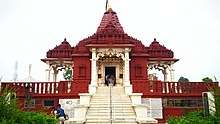
The renowned Son Bhandar Caves is situated at Rajgir, Nalanda district in Bihar state. Son Bhandar group of caves has two caves known as eastern and western cave. Son bhandar caves are concerned with Jainism and considered to belong to 3–4 century AD.
.jpg)
These caves were first inspected by Cunninghum and he concluded to have analogy with Saptaparni Cave of Buddhism creed. After Cunninghum several scholars visited this place and some had opinion to concern with Buddhism. After some time all Buddhism connections were refused because of an inscription found on the southern wall of a cave.
According to this inscription these caves were built by inspiration of a Jain Muni Vair for Jain ascetics. Sculptures of Teerthankaras were also carved in these caves. From architectural aspect; these caves are analogous to Nagarjuni cave and Barabar Caves caves of Mauryan era. Therefore, it can be concluded that construction time should not be much differ from above mentioned caves.
These caves should be related to Digambar sect of Jainism as Xuanzang wrote in his book about Vaibhar Hill of Rajgir that the place was occupied by Digambar Jain monks for meditation purpose. After some centuries these caves were converted by Hindus as Lord Vishnu sculpture was also found from mound of a cave.[12]
Historically, Rajgir has been a very important place in Jainism, as capital to many empires. The main tourist attractions include the ancient city walls from Ajatshatru's period, the Bimbisar's Jail, Jarasandh's Akhara, Gridhra-kuta, ('Hill of the Vultures'), Son Bhandar Caves[13] and the Jain temples on the five peaks.[12]
Rajgir is famous for its hot water springs, locally known as Brahmakund, a sacred place for Hindus where water from seven different springs (Saptarshi) merge and is notable for its healing effects.[14][15]
Another major attraction is the peace pagoda, Vishwa Shanti Stupa, built in 1969, one of the 80 peace pagodas in the world, to spread the message of peace and non-violence. It is the oldest peace pagoda in India. The rope-way that leads to it is another attraction, which was gifted by Japanese spiritual leader Fuji Guruji in the 1960s.
The Japanese temple is beside the Venu Vana. Venu Vana is an artificial forest, where one can enjoy Eternal peace and was used by Budhha for meditation, and meditate and famous Makhdoom Kund. Sri Ramakrishna Math is a non-political spiritual organization which have been engaged in various forms of humanitarians, social service activities.
Rajgir Heritage Museum is another place of Interest, recently inaugurated by CM Nitish Kumar.[16]
The newly developed spot of Pandu Pokhar is worth visiting. The Sariputta Stupa is located on the Peak Of Giriyak Hills, at some distance from Ghora Katora Lake.
Localities in Rajgir: Ashoknagar, Bengali Para, Chak Par, Dangi Tola, Dharmashala Road, Dhurwa More, Gandhi Tola, Ganj Par, Kali Bari, Kailash Ashram, Rajgir Kund, Mahadevpur, Mali Tola, Nahi Pokhar, Nichli Bazaar, Panchmukhi Kuan, Panditpur, Purvi Bharat, Ramhari Pind, Sabalpur, Sithoura, Tulsi Gali, Thakurbari, Upadhyay Tola.
Demographics
According to 2011 Indian Census, Rajgir had a total population of 41,587, of which 21,869 were males and 19,718 were females. Population within the age group of 0 to 6 years was 6,922. The total number of literates in Rajgir was 24,121, which constituted 58.0% of the population with male literacy of 65.4% and female literacy of 49.8%. The effective literacy rate of 7+ population of Rajgir was 69.6%, of which male literacy rate was 78.1% and female literacy rate was 60.1%. The Scheduled Castes and Scheduled Tribes population was 11,724 and 42 respectively. Rajgir had 7030 households in 2011.[3]
As of the 2011 India census,[17] Rajgir had a population of 41,587. Males constitute 53% of the population and females 47%. Rajgir has an average literacy rate of 52%, lower than the national average of 59.5%: male literacy is 61%, and female literacy is 41%. In Rajgir, 19% of the population is under 6 years of age.
Transportation
Bihar State Tourism Development Corporation provides travel facility from state capital Patna to visit Bodh circuit (Bodhgaya, Rajgir, Nalanda, Vaishali, Kesaria, Lumbini, Kushinagar, Sarnath), Jain Circuit (Rajgir, Pawapuri) and Sikh Circuit in Bihar.
- Air: The nearest is Gaya International Airport, Gaya which is 78 km which is connected to International Destinations like Bangkok, Columbo, etc. Another airport is at Patna 101 km. Air India, Indigo, Jet Airways and Go Air connect Patna to Kolkata, Bengaluru, Mumbai, Delhi, Ranchi and Lucknow.
- Rail: Rajgir railway station connects the city to other parts of country yet the nearest convenient railhead is at Gaya Junction railway station 78 km. The Bakhtiyarpur-Gaya line provides improved rail connectivity to many places. It is one of the destination of the prestigious Buddhist pilgrimage train of Indian Railways-Mahaparinirvan Express.
- Road: Rajgir is connected by road to Patna – 110 km, Nalanda – 12 km, Gaya – 78 km, Pawapuri – 19 km, Bihar Sharif – 25 km, etc. NH 120, transverses the city of Rajgir, connecting it with Bodhgaya, Gaya, Nalanda, Bihar Sharif and further to Patna. State Highway 71 also passes through Rajgir connecting it with Giriyak, Islampur and Jahanabad.
- Bus: Regular buses are available from all the above said points to Rajgir.
- Local Transport: Taxis and Buses and Tongas are available.
Economy
The economy of the city mainly depends upon tourism and supplemented by agriculture.A large number of luxurious resorts and hotels are located in Rajgir to serve the tourists. In addition, Rajgir is located near the tourism spots like Nalanda, Pawapuri and Kundalpur.
Rajgir ranks top in Bihar, in reference to revenue collected by tourism.
- An ordinance factory of Indian Defence Service, only of its kind in Bihar is located in the city.
- Rajgir is also home to Bihar Police Academy.
- RTC CRPF – Rajgir is also home to Recruit Training center for Central Reserved Police Force of three states namely Bihar, Jharkhand and West Bengal.]
- Government of Bihar has acquired 100 acres land to build an IT city near Nalanda university and also develop India's first multi-media hub which will provide advance courses in different spheres of IT.[18]
Sports
Nalanda International Cricket Stadium is a proposed cricket stadium in the city. In 2013, it was announced by the Chief Minister of Bihar Nitish Kumar that an international cricket stadium will be constructed at Rajgir in Bihar's Nalanda district.[19][20]
Nalanda International University
Nalanda University, a modern university that is based on the famous university and Buddhist monastery of ancient India, has been established with its campus in Rajgir. It began its first academic session on 1 Sept, 2014.
Rajgir Wildlife Sanctuary
Rajgir or Pant Wildlife Sanctuary, is situated in Nalanda Forest Division covering an area of 35.84 km2 under the Nalanda district administration. This Wildlife Sanctuary represents a remnant patch of forests nestled in the picturesque Rajgir hills within the South Gangetic Plain. This sanctuary provides numerous ecosystem services to the surrounding landscape including varieties of flora and fauna. Therefore, to protect this forest a 35.84 km2 was notified as Rajgir Wildlife Sanctuary in 1978.
It is home to number of wild animals viz. Mammals;Blue bull (Boselaphus tragocamelus), Chital or Spotted deer (Axis axis), Indian crested porcupine (Hystrix indica), Small Indian civet (Viverricula indica) Jungle cat (Felis chaus), Birds; Painted spurfowl (Galloperdix lunulata), Eurasian thick knee (Burhinus oedicnemus) and Painted sandgrouse (Pterocles indicus) Reptiles; Bengal monitor (Varanus bengalensis) and amphibians can be seen in this region; Indian Bullfrog (Hoplobatrachus tigerinus), Jerdon's bullfrog (Hoplobatrachus crassus), Ornate narrow-mouthed frog (Microhyla ornata), Indian tree frog (Polypedates maculatus) etc. Landscape of Rajgir WLS is uneven terrain enclosed by five mountains; Ratnagiri, Vipulgiri, Vaibhagiri, Songiri and Udaygiri.
Events
- Rajgir Mahotsav
- Purushottam Maas Mela
- Sariputta World Peace Walk
- Makar Sankranti Mela
Silao(Nalanda)
Silao, a small town located on the way from Rajgir to Nalanda, is famous for its delicious sweet called "Khaja". It is the only sweet from Bihar that has Geographical Indication(GI) tag.
In popular culture
The World Peace Pagoda and the ropeway to it on Ratnagiri Hills were filmed in the song "O Mere Raja" of the 1970 movie Johnny Mera Naam, starring Dev Anand and Hema Malini.
Notable people
- Bimbisara, ruler of Haryanaka Dynasty
- Ajatashatru, ruler of Haryanaka Dynasty
- Udayin, ruler of Haryanaka Dynasty
- Sariputta, one of the favourite disciples of Budhha
- Jivaka, a physician and contemporary of Bimbisara and Buddha
- Satyadev Narayan Arya, Governor of Haryana, former 8-time MLA from Rajgir and former Minister of Mines and Geology of Bihar
- Jabir Husain
Picture gallery
.jpg)
 Son Bhandar second cave sculptures
Son Bhandar second cave sculptures Boar's Cave, Rajgir.
Boar's Cave, Rajgir. Shri Dhannasheth Jain Temple
Shri Dhannasheth Jain Temple- Jarasandha's Akhara
 Closeup of Buddha at Vishwa Shanti Stupa
Closeup of Buddha at Vishwa Shanti Stupa Remains of an ancient Buddhist Stupa Near NH 120 in Rajgir
Remains of an ancient Buddhist Stupa Near NH 120 in Rajgir- Jain Rock sculptures at Son Bhandar Caves
 Buddhist monks meditating on Vulture's Peak
Buddhist monks meditating on Vulture's Peak Venu Van
Venu Van The stupa of Ajatashatru in Rajgir
The stupa of Ajatashatru in Rajgir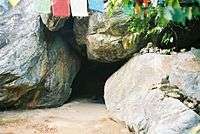 Buddha's cave, Griddhakuta Hill, Rajgir
Buddha's cave, Griddhakuta Hill, Rajgir
See also
- Nalanda University at Rajgir
- Rajgir hills
- Atanatiya Sutta
- Rajgir Mahotsav
- Legendary kings of Magadha
- Bhadda Kundalakesa
- Nahub
- Nalanda
- Kurkihar hoard
- Cyclopean Wall of Rajgir
- Ghora Katora
- Pant wildlife sanctuary Rajgir
References
- "Pinddaangaya.in". www.pinddaangaya.in.
- [ "पत्रांक-213 : राजगीर क्षेत्रीय आयोजना क्षेत्र एवं बोधगया आयोजना क्षेत्र के सीमांकन एवं घोषणा"] Check
|url=value (help). Urban Development Housing Dept., Government of Bihar, Patna. 15 April 2015. Archived (PDF) from the original on 18 June 2015. Retrieved 18 May 2015. - "Census of India: Rajgir". www.censusindia.gov.in. Retrieved 7 January 2020.
- "BSTDC". BSTDC.
- Jain Dharma ka Maulik Itihas Part-1, Ed. Acharyashri Hastimalji Maharaj, 1971 p. 739-742
- "Rajgir – The Abode of Kings". Times of India Travel.
- "Rajgir: On Hallowed Ground". www.livehistoryindia.com.
- "Excursion tour of Rajgir & Nalanda from Bodhgaya | Rajgir, India Activities". Lonely Planet.
- W. Vivian De Thabrew (2013). Monuments and Temples of Orthodox Buddhism in India and Sri Lanka. AuthorHouse. p. 35. ISBN 9781481795517. Archived from the original on 29 November 2016. Retrieved 29 November 2016.
- See Bhagavata Purana, 10.70.30
- "Krsna, the Supreme Personality of Godhead". Archived from the original on 21 April 2008. Retrieved 25 April 2008.
- History behind Son Bhandar cave of Rajgir. Archived 4 March 2016 at the Wayback Machine – JainGlory.com
- Middle Land, Middle Way: A Pilgrim's Guide to the Buddha's India, Shravasti Dhammika, Buddhist Publication Society, 1992 p. 98
- Kishore Sharma, Jugal (February 2014). Punya Bhoomi Bharat. Suruchi Prakashan. p. 70. ISBN 978-9381500095.
- "गर्म पानी के इस कुंड में नहाने से होती है सभी बीमारिया दूर". News Track. 11 February 2017. Archived from the original on 19 April 2018. Retrieved 7 January 2020.
- "Rajgir Heritage Museum inaugurated by CM Nitish Kumar". 8 September 2013. Archived from the original on 11 September 2013. Retrieved 8 September 2013.
- "Census of India 2001: Data from the 2001 Census, including cities, villages and towns (Provisional)". Census Commission of India. Archived from the original on 16 June 2004. Retrieved 1 November 2008.
- "23rd February 2002: When Gilchrist Hit a Record-breaking Double Ton". News18. 23 February 2018.
- "Land in Rajgir for cricket stadium on Ranchi model". www.telegraphindia.com. Archived from the original on 24 September 2015. Retrieved 7 January 2020.
- "Bihar to construct world class cricket stadium". Zee News. 11 December 2013. Archived from the original on 4 March 2016. Retrieved 7 January 2020.
External links
| Wikimedia Commons has media related to Rajgir. |
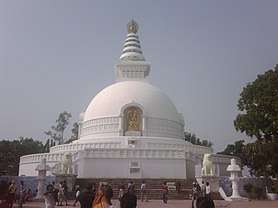
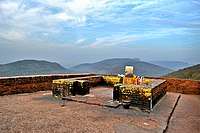

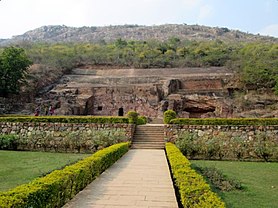
.jpg)